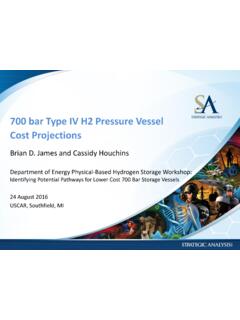Transcription of Hydrogen Storage Figure 2 - Energy
1 Hydrogen Storage Compact, reliable, safe, and cost- effective Storage of Hydrogen is a key challenge to the widespread commercialization of fuel cell electric vehicles (FCEVs) and other Hydrogen fuel cell applications. While some light- duty FCEVs with a driving range of over 300 miles are emerging in limited markets, affordable onboard Hydrogen Storage still remains as a key roadblock. Hydrogen has a low Energy density. While the Energy per mass of Hydrogen is substantially greater than most other fuels, as can be seen in Figure 1, its Energy by volume is much less than liquid fuels like gasoline.
2 For a 300 mile driving range, an FCEV will need about 5 kg of Hydrogen . At 700 bar (~10,000 psi) a Storage system would have a volume of about 200 liters or 3-4 times the volume of gasoline tanks typically found in cars today. A key challenge, therefore, is how to store sufficient quantities of Hydrogen onboard without sacrificing passenger and cargo of the effort of the Hydrogen Storage program is focused on developing cost-effective Hydrogen Storage technologies with improved Energy density. Research and development efforts include high- pressure compressed Storage and materials-based Storage Hydrogen Storage solutions and research needs The first generation of FCEVs use 700 bar Type IV pressure vessels to store Hydrogen .
3 Type IV pressure vessels, as shown in Figure 2, have a plastic liner overwrapped by expensive carbon-fiber composite material to provide strength. The use of carbon fiber composites result in significantly lower weight than all metal pressure vessels would have. The use of Type IV pressure vessels, however, increases the cost of storing Hydrogen in FCEVs, primarily due to the high cost of the carbon fiber composite material, as can be seen in Figure 3. The cost of high-strength carbon fiber comes almost equally from the cost of the precursor fiber and the conversion of the precursor fiber to carbon fiber.
4 To reduce the cost of high-strength carbon fiber, the program has focused on developing lower cost precursor fibers, however cost reduction strategies for conversion processes are also being considered. Other cost reduction efforts for compressed Hydrogen Storage systems include developing alternative lower cost and high performance fiber and resin materials, composite additives for improved performance, and alternative pressure vessel manufacturing processes and identifying alternative materials for balance-of-plant components.
5 Analysis of 700 bar in 2015 projected a 12% reduction in the cost of Type IV onboard systems compared to the 2013 baseline system research directionsLonger-term research focuses on developing advanced Hydrogen Storage technologies that can meet the challenging performance levels required Figure 2: A schematic of a Type-IV Composite Overwrapped Pressure Vessel (COPV) designed for compressed Hydrogen Storage on-board Fuel Cell Electric Vehicles (FCEVs)(Credit: Process Modeling Group, Nuclear Engineering Division. Argonne National Lab (ANL)) Figure 1: Gravimetric and volumetric Energy densities of common fuels based on lower heating values calculated for ambient temperature 3: Potential strategy to meet cost target (700 bar cH2).
6 To meet the ultimate cost target for 700 bar systems, the bulk of cost reductions must come from reducing the amount and costs of carbon fiber composite materials and Balance-of-Plant (BOP)TPRD=Thermally Activated Pressure Relief DeviceFUEL CELL TECHNOLOGIES OFFICEfor FCEVs while providing greater Energy density than 700 bar compressed Hydrogen at competitive cost. There are two key approaches being pursued: 1) use of sub-ambient Storage temperatures and 2) materials-based Hydrogen Storage shown in Figure 4, higher Hydrogen densities can be obtained through use of lower temperatures.
7 Cold and cryogenic-compressed Hydrogen systems allow designers to store the same quantity of Hydrogen either in smaller volumes at the same pressure, or in the same volume at lower pressures. The program supports efforts to develop and evaluate insulated system designs that minimize heat leakage into the vessels so that the Hydrogen can be stored for extended periods of time without the need for venting. Efforts also support a better understanding of material performance under these temperature and pressure can also be densely stored in materials at low pressures.
8 Atomic Hydrogen can bind with other elements to form compounds or solid solutions and molecular Hydrogen can adsorb onto the surface of porous solids, providing the potential for higher Storage densities at significantly lower pressures. Two types of metal hydrides investigated as reversible (or rechargeable) Storage materials include a) intermetallic (or interstitial) hydrides where Hydrogen occupies interstitial spaces within metal alloys ( , LaNi5H6), and b) complex hydrides where Hydrogen covalently bonds to a metal to form a multi-element anion that combines with another metal(s) through ionic interactions ( , Na(AlH4)).
9 In chemical Hydrogen Storage materials, also known as off-board regenerable materials, the Hydrogen typically bonds to other elements through either covalent bonds ( , NH3BH3) or ionic interactions ( , CaH2). The Hydrogen is released from chemical Hydrogen Storage materials through non-equilibrium processes so the now-depleted materials have to be removed and chemically processed to regenerate the original Hydrogen containing material. Hydrogen sorbents are high-surface area, micro-porous solids ( , activated carbons or metal-organic frameworks (MOFs)) where the diatomic Hydrogen molecule adsorbs onto the surface through van der Waals interactions.
10 The challenge for all Hydrogen Storage material development efforts is to develop cost-effective materials with high Hydrogen density by volume and mass. Moreover, these materials must be capable of fast charge/discharge rates within the temperature and pressure ranges of fuel cell operation and be able to undergo sufficient charge/ discharge cycles to last the lifetime of the FCEV. The program has supported three multi-partner programs (Centers of Excellence) and independent projects investigating Hydrogen Storage materials, but gaps still remain in the foundational understanding of the interaction of Hydrogen with Storage materials.


















